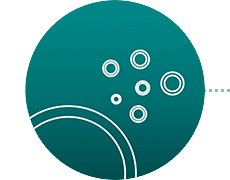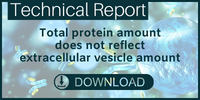Exosome Research
Exosomes are a type of extracellular vesicle (EV) with a diameter of 30-100 nm released from cells. It contains nucleic acids (mRNA, microRNA) and proteins, and there is increasing interest in its role as a tool in intercellular communication and its use as a biomarker in various diseases including cancer. However, exosome experimental technology is still under development and there are many issues.
In collaboration with Professor Hanayama (Department of Immunology, Kanazawa University Graduate School of Medical Sciences), Fujifilm Wako established a "PS affinity method" using Tim4, a protein that binds phosphatidylserine (PS) present on the surface of exosomes in a calcium ion-dependent manner. We have developed an exosome isolation kit. This kit enables the isolation of exosomes with high purity and less damage compared to conventional methods.
Fujifilm Wako can offer the solution of EV research!
| Process | 
Production
|

Isolation/ Purification
|

Detection/ Determination
|

Analysis
|
|---|---|---|---|---|
| Overview | Cultured cells release exosomes. The amount of production varies depending on the medium. | Isolated and purified from culture supernatants or body fluid samples. The purity and recovery amount differ depending on the method. | Exosomes are detected and quantified using exosome surface marker protein etc. | Analyze nucleic acids (miRNA and mRNA), proteins, lipids, etc. included in exosomes. |
| Product | Culture Media Culture Plate Purified Exosome |
Isolation Kits (★) Blocking Reagents |
ELISA Kits (★) Flow Cytometry Kits (★) Antibodies |
RNA Isolation Kits Protein Analysis Reagents |
★: Contains products based on "PS affinity method"
Product Line-up
More Information
What are Exosomes?
Rikinari Hanayama Professor, Department of Immunology, Kanazawa University Graduate School of Medical Sciences
In recent years, research of extracellular vesicles (EVs) has been advancing at an accelerating pace. While the number of scientific articles on EVs published in 2011 was approximately two hundred, the number increased to more than one thousand in 2016 and involvement of EVs in various physiological functions and pathogenic mechanisms has been suggested. Although EVs are roughly classified into at least two categories: exosomes derived from endosomes and microvesicles derived from the plasma membrane, it is difficult to strictly separate them from each other by differential centrifugation, the technique most frequently used for purification of EVs at present, and the EVs not sedimenting at 10,000×g are called "small EVs" (mainly composed of exosomes) for convenience.1)
Exosomes are small membrane vesicles (approximately 30-100 nm in diameter) secreted by various cells and present in most body fluids (e.g., blood, urine, and spinal fluid) and cell culture liquids. Exosomes, membrane vesicles surrounded by a lipid bilayer, are generated within intracellular vesicles called "multi-vesicular endosomes" and released into the extracellular space by fusion of multi-vesicular endosomes with the cell membrane. Exosomes contain proteins from secretory cells, including those of endosome origin (e.g., ESCRTs), those involved in intracellular transport (e.g., Rab GTPase), and those of cell membrane origin (e.g., CD63 and CD81), as well as RNAs. Exosomes also contain the cell membrane of secretory cells and lipids from the endosome membrane (cholesterol and sphingomyelin, etc.).2)
Although exosomes had long been considered to be involved in release of unnecessary cell contents, exosomes are recently attracting attentions of researchers as new mediators of cell-cell communication transporting biomolecules such as lipids, proteins, and RNAs in vivo. In addition to clarifi cation of physiological or pathophysiological functions of exosomes, research aiming at clinical application of these functions is rapidly in progress, particularly focusing on diagnostic and therapeutic application as well as development of biomarkers.
Resources
Posters and presentation materials that we have presented are here.
If you want to see other review articles and technical reports, please see Wako blog.
▼ Poster
| Title | Conference | Year | Language | Data |
|---|---|---|---|---|
| A novel affinity-based method for the isolation of highly purified extracellular vesicles | International Society for Extracellular Vesicles etc. | 2017 | English | |
| Flow cytometry of exosomes using the PS affinity method | Consortium of Biological Science 2017 (ConBio2017) | 2017 | Japanese | |
| Development of high sensitive Exosome ELISA by using PS affinity | Consortium of Biological Science 2017 (ConBio2017) | 2017 | English | |
| Characteristics of PS-affinity method for isolation and detection of EVs | International Society for Extracellular Vesicles etc. | 2018 | English | |
| A novel affinity-based method for isolation and quantification of extracellular vesicles | International Society for Extracellular Vesicles | 2019 | English |
▼ Presentation
| Title | Conference | Year | Language | Data |
|---|---|---|---|---|
| Characteristics on PS Affinity for Isolation and Detection of EVs: Advantages Clarified from Comparison with Conventional Methods | German Society for Extracellular Vesicles etc. | 2019 | English | |
| Novel extracellular vesicle purification technology - PS affinity method - | Congress of the Japanese Society for Regenerative Medicine | 2020 | Japanese | |
| Purification of highly active MSC-derived extracellular vesicles realized by PS affinity method | Japanese Society for Extracellular Vesicles | 2020 | Japanese | |
| TIM4 affinity methods targeting phosphatidylserine for isolation or detection of extracellular vesicles (PS affinity methods) | International Society for Extracellular Vesicles | 2022 | English |
▼ Technical Reports / Application Notes
| Title | Year | Language | Data |
|---|---|---|---|
| High-throughput exosome isolation: a new frontier in exosome research | 2020 | English | |
| Total protein amount does not reflect extracellular vesicle amout - Comparison of EV yields evaluated by tetraspanin ELISA - |
2022 | English |
▼ Movie
| Movie | Title | Language | Data |
|---|---|---|---|
| How to purify exosomes/EVs - Outline of Procedure of MagCapture Exosome Isolation Kit PS Ver.2 (Youtube 7:48) |
English | Youtube | |
| [Protocol] MassivEV™ EV Purification Column PS (Youtube 3:26) |
English | Youtube | |
| [Protocol] microRNA Extractor® Kit for Purified EV (Youtube, 5:02) |
English | Youtube | |
| Detection of Proteins inside Exosome (Youtube 5:22) |
English | Youtube | |
| TIM4 affinity methods targeting phosphatidylserine for isolation or detection of extracellular vesicles (PS affinity methods) (Youtube 21:30) |
English | Youtube | |
| Products for EV Detection (Youtube 4:54) |
English | Youtube |
* Unauthorized copying and replication of the contents of this site, text and images are strictly prohibited.
The information written in this resources are as of the date presented.
For research use or further manufacturing use only. Not for use in diagnostic procedures.
Product content may differ from the actual image due to minor specification changes etc.
If the revision of product standards and packaging standards has been made, there is a case where the actual product specifications and images are different.








